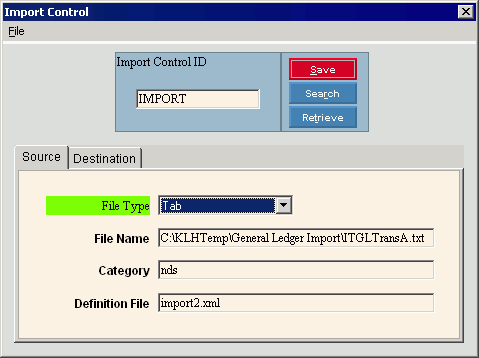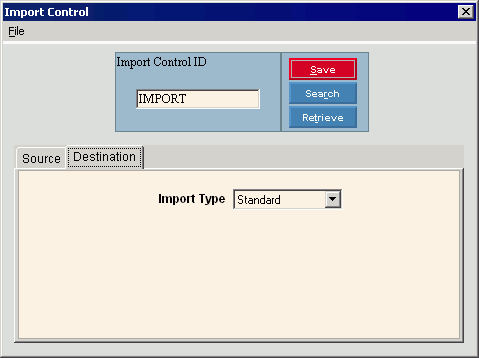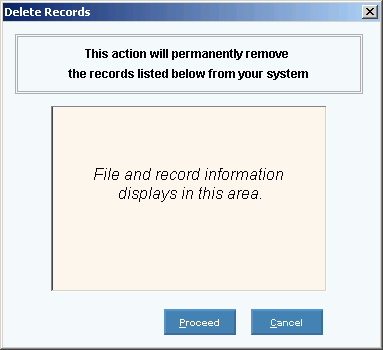Opening Import Control Maintenance, click More.
-
Click Utilities from the Menu Bar.
-
Click Imports Menu.
-
Click Import Control.
Tip: Or, use the keyboard shortcut: [ALT] [t] [i] [c].
Import Control Maintenance - Source Tab Example:

Import Control Maintenance - Destination Tab Example:

Creating a new Import Control Record, click More.
To create a new record choose one of these methods:
-
Enter the new Import Control ID and click Retrieve
 ,
or press [ENTER].
,
or press [ENTER].
Keyboard shortcut: [ALT + t] -
Or, enter the new Import Control ID and click File from the Menu Bar; next click New.
Keyboard shortcut: [ALT] [f] [n]
Tip: To
indicate that you are building a new import control record, New  displays near the Import Control ID. Default
entries display and the first field is highlighted
to let you know you can begin entering information.
displays near the Import Control ID. Default
entries display and the first field is highlighted
to let you know you can begin entering information.
|
Import Control Maintenance Prompts Tip: To see more information about a field, click the hyperlink for the field name. | |
|
Enter the Import Control ID. (up to 20 characters) Required | |
|
|
To update the new or changed information, click Save or press [ENTER]. Keyboard shortcut: [ALT + s] |
|
To avoid losing data, you must save new or changed records. | |
|
|
To view all of the existing Import Control Records, click Search. From the Search list you can select the record to change or delete. Keyboard shortcut: [ALT + r] |
|
|
To display an existing Import Control Record, enter the Import Control ID and click Retrieve, or press [ENTER]. Keyboard shortcut: [ALT + t] |
|
Source Tab | |
|
To specify the type of file, click one of the options in the drop-down list. (predefined) | |
|
Enter the path and file name for the input file. (up to 80 characters) Tip: The path can be overridden during the Journal Import routine. | |
|
Enter the Import Category. (up to 30 characters) Note: For General Ledger, the Category is always nds (lower case) unless otherwise specified by NDS Technical Support. | |
|
Enter the name of the Import Definition File, which is an XML file that defines the layout of the fields in the import file. (up to 30 characters) Note: For General Ledger, the Definition File is always import2.xml unless otherwise specified by NDS Technical Support. | |
|
Destination Tab | |
|
To specify the Import Destination Type, click one of the options in the drop-down list. (predefined) Note: For General Ledger, the Import Type is always Standard unless otherwise specified by NDS Technical Support. | |
Editing an existing Import Control Record, click More.
 CAUTION: To
avoid losing data, you must save new or changed records.
CAUTION: To
avoid losing data, you must save new or changed records.
-
To display the record to be changed, enter the Import Control ID and click Retrieve
 , or press [ENTER].
, or press [ENTER].
Keyboard shortcut: [ALT + t]
Tip: If you do not know the Import Control ID, you can click Search to see a list of Import Control Records.
to see a list of Import Control Records. -
To position the pointer to the information that you want to change, press [TAB] or click the field using the mouse.
-
Enter the data changes.
-
To complete the edit process, click Save
 , or press [ENTER].
, or press [ENTER].
Keyboard shortcut: [ALT + s]
Deleting an existing Import Control Record, click More.
-
To display the record to be deleted, enter the Import Control ID and click Retrieve
 , or press [ENTER].
, or press [ENTER].
Keyboard shortcut: [ALT + t]
Tip: If you do not know the Import Control ID, you can click Search to see a list of Import Control Records.
to see a list of Import Control Records.
-
Click File from the Menu Bar, and next click Delete.
Keyboard shortcut: [ALT] [f] [d] -
At the Delete Records prompt, click Proceed to delete the record, or click Cancel to escape from the delete routine.
Example:
Note: After you click Proceed, you will see the following message on the Status Bar.
Journal Import File Sample(s), click More.
Journal Import File Sample:
